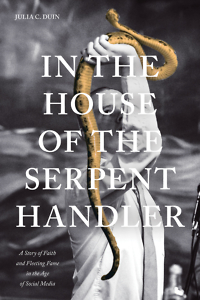Faith and Serpents
Julia C. Duin turns up a sordid tale at the fringes of American religion
Julia C. Duin’s In the House of the Serpent Handler is many things at once. A journalistic account of Pentecostal Holiness churches where parishioners handle deadly venomous snakes, the book reads at times like a travel narrative. (The author has a painterly eye, and her depictions of Appalachian landscapes are especially appealing.) At other times, In the House of the Serpent Handler is an account of social-media dust-ups that follow romantic liaisons among a core group of the faithful. At still others, the book is a memoir, as Duin immerses herself in the community, establishing relationships and describing her own life among the keepers and observers of the culture.
 The tragic hero of the book is a charismatic young serpent-handling pastor named Andrew Hamblin, who calls himself “the Jimmy Swaggart of snake-handling.” Hamblin’s struggles begin after he gains a limited fame on a short-lived National Geographic show called “Snake Salvation.” Duin zeroes in on Hamblin’s rise and then fall from grace, including its awful aftermath, which leaves the snake-handling movement in disarray and Hamblin’s family—his “house”—in near total destitution.
The tragic hero of the book is a charismatic young serpent-handling pastor named Andrew Hamblin, who calls himself “the Jimmy Swaggart of snake-handling.” Hamblin’s struggles begin after he gains a limited fame on a short-lived National Geographic show called “Snake Salvation.” Duin zeroes in on Hamblin’s rise and then fall from grace, including its awful aftermath, which leaves the snake-handling movement in disarray and Hamblin’s family—his “house”—in near total destitution.
The churches in Duin’s tale are death-haunted. Snake handlers perch on a knife-edge where outrageous risk and tremendous faith meet. The crowning moment in the service comes when, moved by the spirit, believers perform different feats of derring-do as a show of faith. Some put their hands over a flame while others take up snakes or swallow poisons like strychnine. As Duin tells it, worshippers never offer detailed theological justifications for what they do—they cite a verse from the gospel of Mark and not much else. Emerging from the ritual unbitten proves the strength of their faith—their “anointing” by God.
Church leaders in the tradition seem remarkably unperturbed by questions that seem obvious to unbelievers. Why would God allow a church leader to die of a snake bite during these services? Do their deaths suggest that victims are something less than “anointed”? For church members, God takes people at an “appointed time,” simple as that. They grieve terribly when someone dies, but they don’t express doubts about their spiritual practice.
 A clear sense of how the practice of taking up serpents might be linked to the history of Appalachia is mostly missing from In the House of the Serpent Handler, though one of Duin’s colorful descriptions conjures something like a Freudian explanation: “The men were clustered around their boxes, gazing at each other’s reptiles.” Masculine contests aside, it’s hard not to wonder whether the precariousness of these lives, teetering just on the edge of total destitution, has something to do with the propensity for risk-taking, but this book doesn’t look for explanations.
A clear sense of how the practice of taking up serpents might be linked to the history of Appalachia is mostly missing from In the House of the Serpent Handler, though one of Duin’s colorful descriptions conjures something like a Freudian explanation: “The men were clustered around their boxes, gazing at each other’s reptiles.” Masculine contests aside, it’s hard not to wonder whether the precariousness of these lives, teetering just on the edge of total destitution, has something to do with the propensity for risk-taking, but this book doesn’t look for explanations.
A believer herself, Duin has a good feel for the texture of religious practice and ritual. Though the folkways of Appalachian Southerners strike her as strange at times, she finds ecstatic experience familiar, and she clearly sides with those who believe the catalogue of religious freedoms in America should include this religious practice. In the wake of a National Public Radio expose on the suffering of snakes in the care of serpent handlers, for example, she offers this odd defense: “Pentecostal serpent handling had been around for more than one hundred years. Why all the fuss now?”
In the House of the Serpent Handler, two dramatic deaths happen in the space of less than two years. Both victims were mentors to Andrew Hamblin, and his grief over their loss contributes to his downfall, a story Duin details in the final third of the book. Those with outwardly strange religious practices are just like the rest of humanity, it turns out—sinners all, with feet of clay.

Peter Kuryla is an associate professor of history at Belmont University in Nashville, where he teaches a variety of courses having to do with American culture and thought. He is also a regular blogger for the Society for U.S. Intellectual History (S-USIH).


